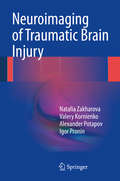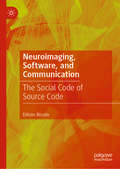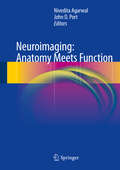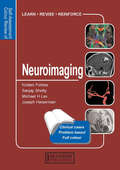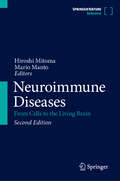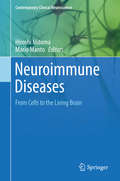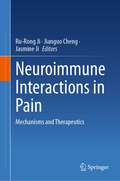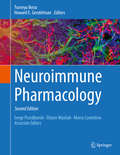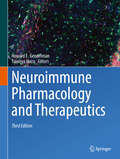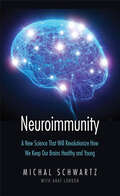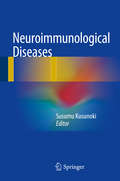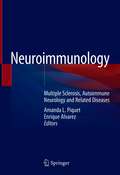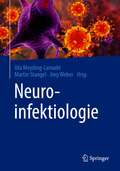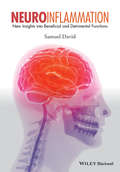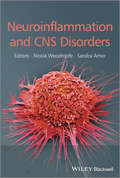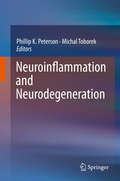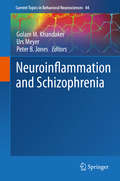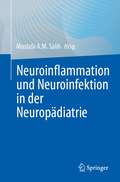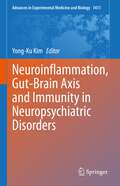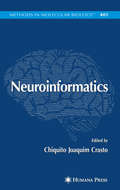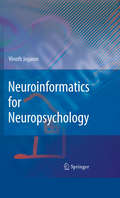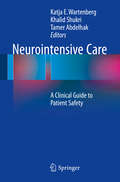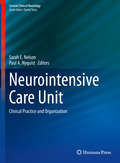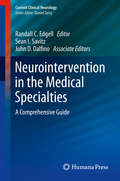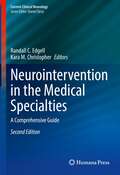- Table View
- List View
Neuroimaging of Traumatic Brain Injury
by Natalia Zakharova Valery Kornienko Alexander Potapov Igor ProninThe main purpose of this book is to present emerging neuroimaging data in order to define the role of primary and secondary structural and hemodynamic disturbances in different phases of traumatic brain injury (TBI) and to analyze the potential of diffusion tensor MRI, tractography and CT perfusion imaging in evaluating the dynamics of TBI. The authors present a new MRI classification of brain stem and hemispheric cortical/subcortical damage localization that is of significant prognostic value. New data are provided regarding the pathogenesis and dynamics of diffuse and focal brain injuries and qualitative and quantitative changes in the brain white matter tracts. It is shown that diffuse axonal injury can be considered a clinical model of multidimensional "split brain" with commissural, association and projection fiber disorders. The book will be of interest for neuroradiologists, neurosurgeons, neurologists and others with an interest in the subject.
Neuroimaging, Software, and Communication: The Social Code of Source Code
by Edison BicudoThis book analyses the social contexts in which programmers design neuroimaging software used in brain studies. It shows that in the same way people engage in everyday communication, programmers are involved in a series of communicative processes to realize the negotiations and discussions generated by software development. In this way, highly technical activities such as computer code writing are also underpinned by values, preferences, and power relations.At the same time, the book sheds new light on scientists’ increasing dependence on software. On the one hand, many scientific tasks can no longer be performed without the help of computational technologies. On the other hand, most scientists have only superficial computing knowledge. As a result, inequalities emerge whereby some scientists take the most strategic methodological decisions whereas other scientists can only rely on the technical help provided by user-friendly computer applications.
Neuroimaging: Anatomy Meets Function
by Nivedita Agarwal John D. PortThis book combines classic MR anatomy with current understanding of human brain function. Recent advances in neuroscience have highlighted the importance of correlating brain anatomy with underlying brain function, since the brain contains a highly sophisticated organization of anatomical and functional relationships that are not readily "visible" with standard imaging. The use of magnetic resonance imaging is rapidly increasing in the field of neuroscience, and remains at the forefront for offering insights into the normal and pathologic structure and function of the human brain. The relatively recent concepts of structural and functional connectivity make it even more important to visualize the brain as a whole rather than looking at its individual parts. This holistic approach is vital in understanding concepts such as neuroplasticity that are currently incorporated into physical and cognitive rehabilitation programs for patients with stroke or neurodegenerative diseases. Ultimately this combined approach may reduce both overdiagnosis and misdiagnosis when integrated into routine clinical routine. This book will be of interest to neuroradiologists, general radiologists and neurologists alike, as well as medical students, residents and fellows.
Neuroimaging: Self-Assessment Colour Review (Medical Self-Assessment Color Review Series)
by Kirsten Forbes Sanjay Shetty Michael Lev Joseph HeisermanThis self-assessment colour review will be useful to neurologists and neuroradiologists in training and practice as it covers the full spectrum of neurological disease using modern imaging techniques - MRI, CT, invasive and non-invasive vascular imaging. The emphasis is on diagnostic neuroimaging in adults and children, with some interventional neu
Neuroimmune Diseases: From Cells to the Living Brain
by Mario Manto Hiroshi MitomaThis Springer Major Reference Work provides a detailed translational overview of neuroimmune diseases for neuroscientists and clinicians, clarifying the pathological mechanisms underlying neuroimmune diseases and building a comprehensive bridge between the latest research findings and their clinical implications in daily practice. The material is presented in two steps. The first section comprises a review of the pathogenic actions of immune cells in brain diseases. Here the authors discuss the mechanisms through which immune cells disrupt the functions of nerve cells. The second section explores the ways in which the brain becomes dysfunctional due to impaired nerve cell function. Based on pathogenesis, diagnostic and therapeutic strategies are discussed for each clinical category. The new edition features updated chapters throughout, including coverage of new findings, new diagnostic criteria, and therapeutic algorithms. Neuroimmune Diseases, 2nd edition, also includes new chapters with a translational approach. The book will be invaluable for use in clinical practice of neuroimmune diseases.
Neuroimmune Diseases: From Cells to the Living Brain (Contemporary Clinical Neuroscience)
by Mario Manto Hiroshi MitomaA translational overview of neuroimmune diseases for neuroscientists and clinicians that clarifies the pathological mechanisms underlying neuroimmune diseases and builds a comprehensive bridge between the latest research findings and their clinical implications in daily practice. The material is presented in two steps. The first section comprises a review of the pathogenic actions of immune cells in brain diseases. Here the authors discuss the mechanisms through which immune cells disrupt the functions of nerve cells. The second section explores the ways in which the brain becomes dysfunctional due to impaired nerve cell function. Based on pathogenesis, diagnostic and therapeutic strategies are discussed for each clinical category. The book will be invaluable for use in clinical practice of neuroimmune diseases
Neuroimmune Interactions in Pain: Mechanisms and Therapeutics
by Jianguo Cheng Ru-Rong Ji Jasmine JiAs lifespans increase, more people around the world find themselves victims of chronic pain. In spite of this, treatment options continue to be severely limited. Anti-inflammatory drugs can only do so much, while painkillers like opioids have led to crippling addictions and fatal overdoses. The subject of the book is the role of immune cells, including glial cells, and neuroimmune interactions in chronic pain. The book begins by examining the preclinical and clinical evidence supporting the involvement of non-neuronal cells in chronic pain. It discusses the interactions between non-neuronal cells and neurons in the regulation of chronic pain. It then presents the implications of these findings, including promising and emerging treatments such as specialized pro-resolving mediators (SPMs, such as resolvins and protectins), immune cell therapy, and complementary and alternative medicine, as well as neuromodulation and regenerative medicine, which may prove to be the turning point for hundreds of millions of patients world-wide who struggle to escape from the shadow of chronic pain. The book presents ground-breaking research that will alter current perspectives on chronic pain.
Neuroimmune Pharmacology
by Howard E. Gendelman Tsuneya IkezuNeuroimmune pharmacology seeks to harness the immune system to provide pharmacological intervention to combat neurodegenerative diseases. This book provides a comprehensive overview of topics that embrace the link between the immune system and the pathogenesis of neurodegenerative disorders. Results from recent studies strongly suggest that a major part of the process in diseases including Alzheimer's and Parkinson's as well as Prion diseases, comes from changes in the innate and adaptive arms of the brain and peripheral immune systems. Thus, the book provides an in-depth study of numerous fields including immunology, pharmacology, neuroscience and neurovirology. It is accompanied by a CD-ROM that includes access to lectures, slide presentations, and question and answers on neuroimmune pharmacology.
Neuroimmune Pharmacology and Therapeutics
by Howard E. Gendelman Tsuneya IkezuBridging neuroscience, immunology, and pharmacology, and bringing together the foremost authorities, Neuroimmune Pharmacology and Therapeutics, 3rd edition, is an invaluable reference and textbook. The text discusses the immunology of the nervous system. New chapters are offered on innate, humoral, and cellular immune responses (innate and adaptive immunity). The additions join each component of the immune response in descriptions for how each affects nervous system function in both health and disease. Next, discussions of neuropharmacology now include both drug development and delivery into brain subregions to optimize clinical responses. This edition features greatly expanded coverage of therapeutics. The new extensions have blossomed into focused therapies engaging the immune system directly, deploying it for drug delivery, attracting the newly evolving field of genetics, vaccinations, and bioengineering, ultimately leading to improved therapeutic disease outcomes. All of the revisions in this edition are designed to bring an early trainee together with a skilled clinical and translational scientist to discuss the state of the art in each part of the emerging field of immunity as it affects the nervous system during steady state and disease and how it can be harnessed for therapeutics and clinical benefit.
Neuroimmunity: A New Science That Will Revolutionize How We Keep Our Brains Healthy and Young
by Michal Schwartz Anat LondonHow pathbreaking research into the brain’s connections to the immune system offers new hope for treating diseases, injuries, and the effects of aging. PROSE Awards Honorable Mention, Biomedicine & Neuroscience categoryIn the past, the brain was considered an autonomous organ, self-contained and completely separate from the body’s immune system. But over the past twenty years, neuroimmunologist Michal Schwartz, together with her research team, not only has overturned this misconception but has brought to light revolutionary new understandings of brain health and repair. In this book Schwartz describes her research journey, her experiments, and the triumphs and setbacks that led to the discovery of connections between immune system and brain. Schwartz, with Anat London, also explains the significance of the findings for future treatments of brain disorders and injuries, spinal cord injuries, glaucoma, depression, and other conditions such as brain aging and Alzheimer’s and Parkinson’s diseases.Scientists, physicians, medical students, and all readers with an interest in brain function and its relationship to the immune system in health and disease will find this book a valuable resource. With general readers in mind, the authors provide a useful primer to explain scientific terms and concepts discussed in the book.
Neuroimmunological Diseases
by Susumu KusunokiThis book offers a detailed review of the remarkable advances that have been made in research on the pathogenesis of a number of neuroimmunological diseases, as well as outlining novel treatments including the use of monoclonal antibodies. Written by renowned experts who have made major contributions in the field, such as identifying neuromyelitis optica as an immunopathological clinical condition, identifying the role of ganglioside and ganglioside-complex antibodies in Guillain-Barré syndrome, and developing a novel treatment for POEMS (polyneuropathy, organomegaly, endocrinopathy, M-protein, and skin changes) syndrome, the book summarizes recent advances in basic and clinical research. Neuroimmunological Diseases is a useful resource for not only researchers but also neurologists who are engaged in the management of neuroimmunological diseases.
Neuroimmunology: Multiple Sclerosis, Autoimmune Neurology and Related Diseases
by Amanda L. Piquet Enrique AlvarezThis book provides a clinical focus on neuroinflammatory diseases as well as a review in pathophysiology and treatment approaches. Organized into six parts, the book begins with a basic review of the immune system and concepts for learning and treating neuroimmune conditions. The next four sections cover specific subfields of neuroimmunology and autoimmune neurology - the clinical and diagnostic features of multiple sclerosis, other autoimmune conditions of the central nervous system, autoimmune conditions of the peripheral nervous system, and systemic autoimmune conditions that affect the nervous system. To conclude, Section six discusses various clinical approaches to specific presentations in neuroimmunology, including pediatric demyelinating diseases. These sections provide practical clinical information to improve the reader’s knowledge in this complex field. The chapters are written by world renown authors with extensive knowledge to help provide up to date information. The full scope of autoimmune neurology is discussed, which is a unique feature of this book. Neuroimmunology serves as a resource for those in training including residents and fellows to provide clear clinical reasoning and background in a rapidly advancing field.
Neuroinfektiologie
by Martin Stangel Uta Meyding-Lamadé Jörg WeberDieses praxisorientierte Buch behandelt ein stetig wachsendes Teilgebiet der Neurologie grundlegend. Es stellt sich den bekannten und den neuen Infektionserkrankungen des zentralen Nervensystems und unterstützt behandelnde Ärzte bei der Diagnosefindung und dem Management. Praxisnah mit übersichtlichen Tabellen, Abbildungen und Kernaussagen, kann dieser kompakte Leitfaden eine wertvolle Hilfe im ärztlichen Alltag sein.Das Werk schult den diagnostischen Blick, der neben der interdisziplinären Zusammenarbeit mit einem Tropeninstitut und neben Ausdauer und Besonnenheit in der Patientenbetreuung von entscheidender Bedeutung ist.
Neuroinflammation
by Samuel DavidNeuroinflammation has long been studied for its connection to the development and progression of Multiple Sclerosis. In recent years, the field has expanded to look at the role of inflammatory processes in a wide range of neurological conditions and cognitive disorders including stroke, amyotrophic lateral sclerosis, and autism. Researchers have also started to note the beneficial impacts of neuroinflammation in certain diseases. Neuroinflammation: New Insights into Beneficial and Detrimental Functions provides a comprehensive view of both the detriments and benefits of neuroinflammation in human health. Neuroinflammation: New Insights into Beneficial and Detrimental Functions opens with two chapters that look at some fundamental aspects of neuroinflammation in humans and rodents. The remainder of the book is divided into two sections which examine both the detrimental and beneficial aspects of inflammation on the brain, spinal cord and peripheral nerves, on various disease states, and in normal aging. These sections provide a broad picture of the role neuroinflammation plays in the physiology and pathology of various neurological disorders. Providing cross-disciplinary coverage, Neuroinflammation: New Insights into Beneficial and Detrimental Functions will be an essential volume for neuroimmunologists, neurobiologists, neurologists, and others interested in the field. neurobiologists, neurologists, and others interested in the field.Neuroinflammation has long been studied for its connection to the development and progression of Multiple Sclerosis. In recent years, the field has expanded to look at the role of inflammatory processes in a wide range of neurological conditions and cognitive disorders including stroke, amyotrophic lateral sclerosis, and autism. Researchers have also started to note the beneficial impacts of neuroinflammation in certain diseases. Neuroinflammation: New Insights into Beneficial and Detrimental Functions provides a comprehensive view of both the detriments and benefits of neuroinflammation in human health. Neuroinflammation: New Insights into Beneficial and Detrimental Functions opens with two chapters that look at some fundamental aspects of neuroinflammation in humans and rodents. The remainder of the book is divided into two sections which examine both the detrimental and beneficial aspects of inflammation on the brain, spinal cord and peripheral nerves, on various disease states, and in normal aging. These sections provide a broad picture of the role neuroinflammation plays in the physiology and pathology of various neurological disorders. Providing cross-disciplinary coverage, Neuroinflammation: New Insights into Beneficial and Detrimental Functions will be an essential volume for neuroimmunologists, neurobiologists, neurologists, and others interested in the field.Neuroinflammation has long been studied for its connection to the development and progression of Multiple Sclerosis. In recent years, the field has expanded to look at the role of inflammatory processes in a wide range of neurological conditions and cognitive disorders including stroke, amyotrophic lateral sclerosis, and autism. Researchers have also started to note the beneficial impacts of neuroinflammation in certain diseases. Neuroinflammation: New Insights into Beneficial and Detrimental Functions provides a comprehensive view of both the detriments and benefits of neuroinflammation in human health. Neuroinflammation: New Insights into Beneficial and Detrimental Functions opens with two chapters that look at some fundamental aspects of neuroinflammation in humans and rodents. The remainder of the book is divided into two sections which examine both the detrimental and beneficial aspects of inflammation on the brain, spinal cord and peripheral nerves, on various disease states, and in normal aging. These sections provide a broad picture of the role neuroinflammation plays in the physiology and pathology of various neurological disorders. Providing cross-disciplinary coverage, Neuroinflammation: New Insights into Bene...
Neuroinflammation and CNS Disorders
by Sandra Amor Nicola WoodroofeThe last decade has seen an upsurge of information on the role of immune responses in neurodegenerative disorders. In many of these diseases it is still unclear whether the innate and adaptive responses are pathogenic or play a role in repair, and thus understanding their precise roles is key to controlling these diseases by designing immune-therapeutic approaches. The connection between many neurological diseases is the realisation that the immune and nervous systems are inextricable linked, and that perturbations in this delicate balance are involved in many disorders. This has opened up new avenues for therapeutic approaches to treatment of CNS inflammatory and neurodegenerative disorders. Neuroinflammation and CNS Disorders brings together the very latest information on the interactions between the immune system and central nervous system. The first section of the book highlights the basic concepts in the field whilst the second section, the main body of the book, covers the role of the immune response in specific disorders of the central nervous system. Neuroinflammation and CNS Disorders will provide an invaluable guide for both researchers and clinicians working in this complex and dynamic field.
Neuroinflammation and Neurodegeneration
by Phillip K. Peterson Michal ToborekState of the art reviews by experts in the fields of neuroscience, immunology, microbiology/infectious diseases and pharmacology addressing the convergence of the immune system (neuroinflammation) and the loss of neurons (neurodegeneration). Many of the diseases that are discussed in the book are of epidemic proportion, e. g. , Alzheimer's disease, Parkinson's disease, stroke, viral encephalitides and substance abuse. In addition to discussions of the involvement of neuroinflammation and neurodegeneration in these disorders, scientific reviews are presented on the cells and mediators that participate in defense of and damage to the nervous system. With rare exception, no or inadequate treatment exists for the diseases discussed in this book. An underlying premise of the book is that understanding of their shared pathogenic mechanisms will lead to improved therapies. Given the rapid evolution of the field of Neuroimmune Pharmacology, readers will find this book to be the most timely and authoritative reference on the subject of each of its chapters.
Neuroinflammation and Schizophrenia (Current Topics in Behavioral Neurosciences #44)
by Golam M. Khandaker Urs Meyer Peter B. JonesThis book provides a comprehensive summary of the cutting edge scientific evidence regarding the role of immune system in the pathogenesis and treatment of schizophrenia and related psychotic disorders. It illustrates the role of inflammation and immunity in schizophrenia drawing on both basic science and clinical research. The chapters provide up-to-date summaries of immunological risk factors for schizophrenia and related psychotic disorders, and underlying mechanisms as informed by neuroimaging, genetic, clinical and animal experimental studies. In addition, the book will illuminate the scope for immunological treatment for schizophrenia.
Neuroinflammation und Neuroinfektion in der Neuropädiatrie
by Mustafa A. M. SalihDieses Buch beleuchtet Aspekte neuroinflammatorischer Erkrankungen bei Kindern und Jugendlichen sowie das Gebiet der Neuroinfektionen in der Pädiatrie. Verfasst von Experten aus führenden Universitätskliniken und Gesundheitszentren sowohl in den Industrieländern als auch in den Entwicklungsländern, verfolgt das praxisorientierte Werk einen problemorientierten Ansatz zu diesen speziellen Erkrankungen des Nervensystems im Kindesalter. Das Buch wurde aus dem Englischen mithilfe von Künstlicher Intelligenz unter Verwendung der DeepL-Software übersetzt. Die Kapitel sind ursprünglich im Werk Clinical Child Neurology erschienen, das von Mustafa A.M. Salih im Springer-Verlag herausgegeben wurde..
Neuroinflammation, Gut-Brain Axis and Immunity in Neuropsychiatric Disorders (Advances in Experimental Medicine and Biology #1411)
by Yong-Ku KimThis book reviews the relationship between cytokines, glia, and neurons in the pathophysiology of neuropsychiatric disorders and examines the mechanisms of action of the drugs used for the treatment of these disorders. Increasing evidence has suggested that glia perform important roles in various brain functions, but much remains to be learned about these crucial cells and their interplay with neurons. In addition, a better understanding of the interaction between inflammatory mediators, such as cytokines, and the activated immune response will be of critical importance for the development of new therapeutic strategies. These key areas are the focus of this book, which documents the latest research findings in the field. Evidence is provided for the role of inflammation-induced toxic metabolites from the tryptophan pathway in a wide range of neuropsychiatric disorders, including depression, schizophrenia, and Alzheimer's disease. In presenting state of the art knowledge on the interactions between cytokines, glia, and neurons, the book will help to pave the way for the development of novel targets for the prevention and treatment of neuropsychiatric disorders.
Neuroinformatics
by S. H. Koslow Chiquito J. CrastoNeuroinformatics presents cutting-edge techniques for the synergistic study of neuroinformatics. The book facilitates the efforts of discovering neuroscience through the sharing of data and the use of computational models. It demonstrates the use of neuroinformatic components as a mechanism for understanding complex disorders. It contains detailed explanations, advantages, and disadvantages of traditional and non-invasive imaging methods.
Neuroinformatics for Neuropsychology
by Vinoth JagarooBioinformatics involves specialized application of computer technology to investigative and conceptual problems in biology and medicine; neuroinformatics (NI) is the practice of bioinformatics in the neurosciences. Over the past two decades the biomedical sciences have been revolutionized by databases, data mining and data modeling techniques. The Human Genome Project, which depended on informatics methods, has been the most well recognized bioinformatics undertaking. Bioinformatics has since been applied all across biology and medicine, and has also transformed almost every avenue in neuroscience. Yet in neuropsychology, NI perspectives remain largely unrealized. Ironically, NI offers enormous potential to the essential praxis of neuropsychology - assessing cognitive behavior and relating cognition to neural systems. Neuroinformatics can be applied to neuropsychology as richly as it has been applied across the neurosciences. Neuroinformatics for Neuropsychology is the first book to explain the relevance and value of NI to neuropsychology. It systematically describes NI tools, applications and models that can enhance the efforts of neuropsychologists. It also describes the implications of NI for neuropsychology in the 21st century - fundamental shifts away from the conventional modes of research, practice and communication that have thus far characterized the field. One of the foremost experts on the subject: Illustrates the vital role NI is playing throughout the neurosciences. Provides a sampling of NI tools and applications in neuroscience research, and lays out current organization structures that support NI. Describes the lack of NI in neuropsychology, differentiates between NI systems for neuropsychology and conventional computerized assessment methods, and proposes criteria for neuropsychology-specific NI systems. Describes NI applications and models currently in use in neuropsychology, and NI models for neuropsychology that are being pioneered in phenomics research. Discusses potential obstacles and aids to NI in neuropsychology, including issues such as data sharing, standardization of methods, and data ontology. Projects the future of neuropsychological research and practice in light of the new generation of the internet, Web 2.0, geared to collective knowledge building. A vital introduction to a profound technological practice, Neuroinformatics for Neuropsychology is important reading for clinical neuropsychologists, cognitive neuroscientists, behavioral neurologists, and speech-language pathologists. Researchers, clinicians, and graduate students interested in informatics for the brain-behavioral sciences will especially welcome this unique volume.
Neurointensive Care
by Katja E. Wartenberg Khalid Shukri Tamer AbdelhakThis book provides guidance for physicians confronted with acute neurological crises in the context of patient safety centred practice standards. It highlights how the implementation of patient safety standards in the neurointensive care unit leads to better clinical outcomes and emphasizes the importance of utilizing appropriate resources, ensuring evidence-based practice is followed. Cost effectiveness, continuous performance improvement and the creation of a non-punitive culture are also discussed. Neurointensive Care: A Clinical Guide to Patient Safety is aimed at physicians around the world caring for critically ill neurological patients either in the emergency department or intensive care unit, and may also be valuable for nurses working in these settings. Neurointensivists, neurologists, neurosurgeons, anesthesiologists, general intensivists, emergency physicians, and trainees dealing with neurological catastrophes will find this book of interest.
Neurointensive Care Unit: Clinical Practice and Organization (Current Clinical Neurology)
by Sarah E. Nelson Paul A. NyquistThis book offers valuable guidance to neurointensivists, other neurocritical care staff, and those desiring to develop a neurocritical care unit via a thorough discussion of neurological emergencies and neurocritical care unit organization.This comprehensive volume begins with a review of acute neurological emergencies as managed clinically in the neurocritical care unit. Topics include acute cerebrovascular, neurological, and neurosurgical disorders. The unique aspect of this book is its description of the organization of the neurocritical care unit. We focus on how other services in the hospital interact with and assist neurocritical care operations, telemedicine/telestroke, and neurocritical care personnel and their roles. A review of expected outcomes of neurocritical care conditions is also included.Neurointensivists, neurocritical care unit staff leadership, hospital administrators, and those interested in developing a neurocritical care unit will find Neurointensive Care Unit: Clinical Practice and Organization to be an invaluable guide.
Neurointervention in the Medical Specialties
by Randall C. Edgell Sean I. Savitz John DalfinoNeurointervention in the Medical Specialties is a first-of-its-kind reference that serves as a bridge between the neurointerventionalist and the physicians who most frequently look to these specialists for answers to some of the most intractable problems they face. Providing background on the wide range of diseases treated through neurointervention along with the indications and alternatives to such treatments, this landmark title is grouped into four parts: an introduction to the tools and anatomical structures that are integral to the field; disease processes most often encountered by neurologists, cardiologists, and vascular surgeons; those diseases more frequently treated by neurosurgeons; and finally those diseases first seen by several other specialties including ophthalmologists and head and neck surgeons. Importantly, each chapter includes details of neurointerventional technique and case discussions that are sufficiently detailed to provide a treatment template and guidance to neurointerventionalists in training and practice. At the same time, the descriptions provide referring physicians with insight into how neurointerventional procedures are performed. Finally, there are several concluding, thought-provoking chapters that examine what new opportunities await the field of neurointervention on the horizon. Neurointervention in the Medical Specialties is a major contribution to the literature and invaluable resource for all clinicians and researchers interested in this exciting field.
Neurointervention in the Medical Specialties: A Comprehensive Guide (Current Clinical Neurology)
by Randall C. Edgell Kara M. ChristopherThis book covers the intersections between neurointervention and neurology, neurointervention and neurosurgery, and neurointervention and other specialties. It fills the gap in the literature by placing specific emphasis on appropriate patient selection, preparation, and post-procedural management. Concise and comprehensive, this text covers the increasingly important aspects of the neurointerventionalist profession, as it has moved away from a purely technical role to a focus on clinical care. In addition, the most rapidly expanding area of neurointervention, ischemic stroke, is thoroughly examined in this text, where other texts on this subject fail. It is also meant as a reference for non-neurointerventionalists who may desire to learn more about how their patients can benefit from the therapeutic or adjunctive techniques that the neurointerventionalist can provide. Neurointervention in the Medical Specialties, Second Edition is an essential guide written for neurointerventional specialists from all backgrounds, both in practice and in training
